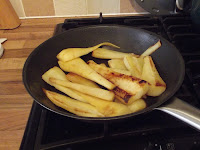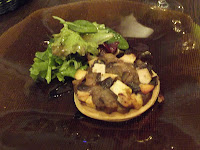The great Easter cookathon has begun- and kicked off in style with Easter Sunday lunch.
Although I love other cuisines- indeed this blog is testament to all the different recipes from around the world that I like to try- you can't beat a British Sunday lunch.
Cooking one is not a Herculean task- it is just simple fare cooked well- but I do love to let someone else
do it and go out every now and then for a pub roast : log fire crackling, rosy cheeks from wine or beer and hearty food. A pub Sunday roast is one of life's great pleasures.
Here are a few roasts I have known and loved:
 |
| Roast Turkey at the Pilot |
 |
Rolled Roast Belly of Pork at the Royal |
 |
| entree gourmand |
To roast chicken to perfection- I like to part-steam/part-roast mine. I place the bird in a casserole dish (glass is best), squeeze lemon juice over it, strategically place the squeezed lemon (in the cavity), drizzle over some olive oil, herbs and salt and pepper- then add a full glass of water to the dish. Pop on the lid and roast for 1- 1and a half hours at 170 degrees depending on the size of the chicken. The water makes the roast beautifully moist and produces a large quantity of jus for gravy- and the glass top ensures that the bird browns nicely in the oven. The chicken is cooked when a knife inserted into the thickest part of the thigh comes out with only clear juices (not pink) bubbling out of the hole.
 |
| Cauliflower cheese |
 |
| Chicken ready for roasting |
 |
| Maple glazed parsnips |
200g of dark chocolate
150 g soft butter
100g sugar
50 g self raising flour
2 whole eggs and 2 egg whites
Beat the egg whites until just forming soft peaks, beat the butter with the sugar and then add the whole eggs one by one. Melt the chocolate in the microwave with a splash of water for 1 minute. Mix it into the eggs and butter, then add the flour. Carefully slide in the egg whites, folding them into the mixture rather than stirring them in. Pour into a greased cake tin and bake at 150 degrees for 25-30 minutes- crucially, until the top is firm but a cocktail stick inserted into the very centre still comes out with some gooey mixture on it. That way you have a chocolate cake with a squidgy centre which is the key to it success.
 |
| Straight out of the oven |
 |
| Moelleux- ready to eat |
A meal like this one generates loads of leftovers- I have half a chicken, some cauliflower cheese, vegetables of all sorts, gravy and half a chocolate cake to finish up.
With the chicken, leeks and gravy, I plan to make a Chow Phan (Chinese rice dish with chicken, spring onions and leeks, bacon, egg, mushroom and anything else I have to hand. Type it into the search box for the recipe).
 |
| Chow Phan |
I also plan to use the carcass to make a chicken, noodle and vegetable soup for later in the week.
With the leftover vegetables, I could make soup or bubble and squeak as you know I often do- but this time I am going to experiment with a vegetable crumble. If it works, I'll post it up on the blog with the recipe.
 |
| Noodle soup |
With the leftover vegetables, I could make soup or bubble and squeak as you know I often do- but this time I am going to experiment with a vegetable crumble. If it works, I'll post it up on the blog with the recipe.
As for the chocolate cake- it will keep on being munched until the last few slices which I plan to chop and make part of chocolate and caramel ice cream sundaes. Photos will follow!
But for now, it's time to curl up with the Sunday papers, a cup of tea and nibble a little Easter egg from my edible table centre piece:










































